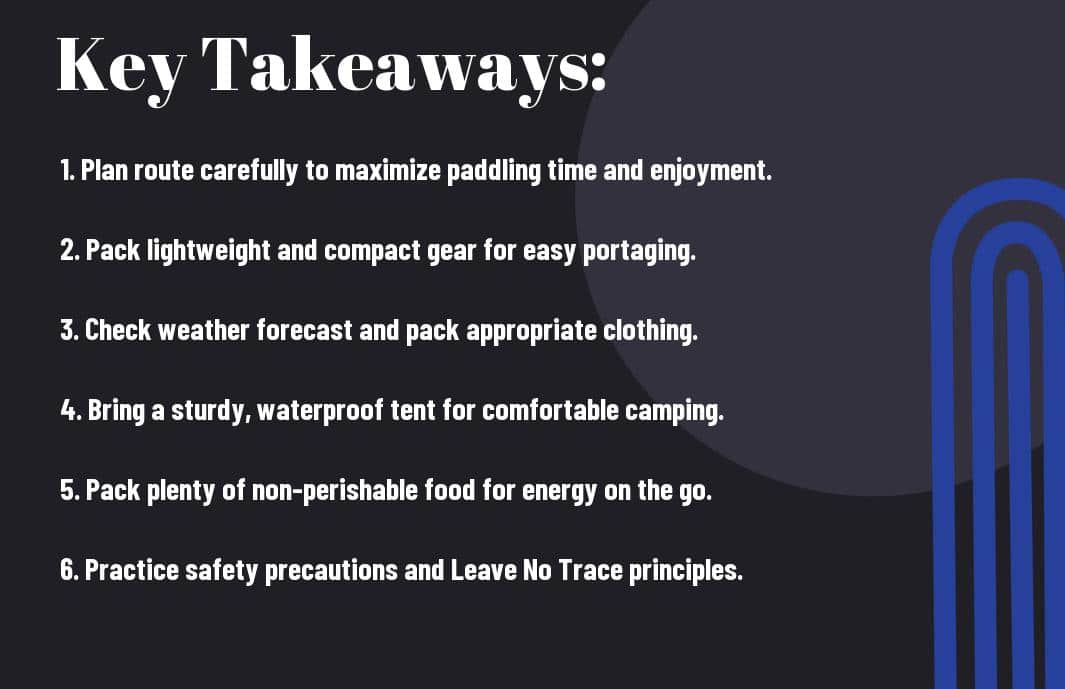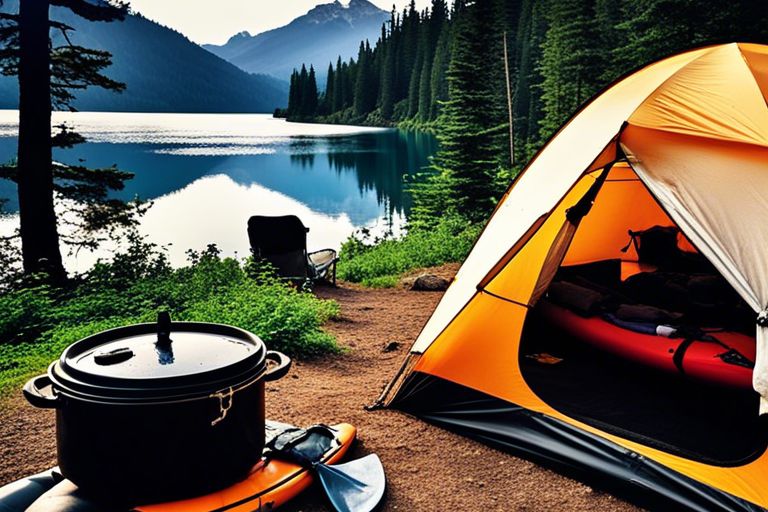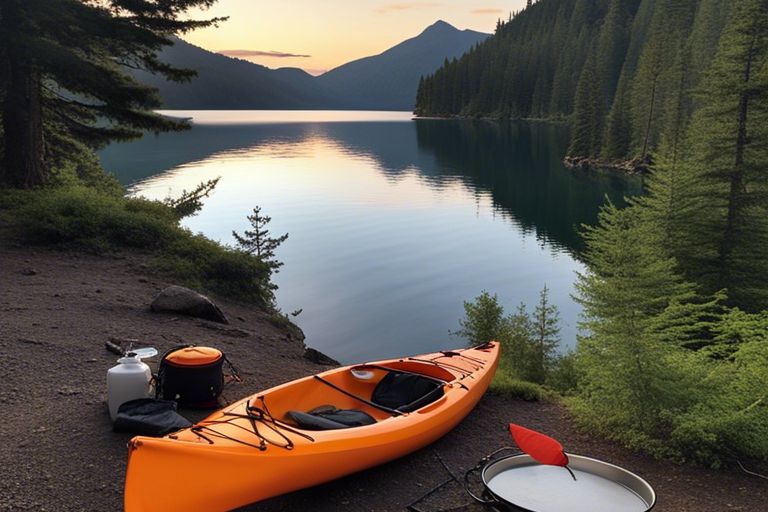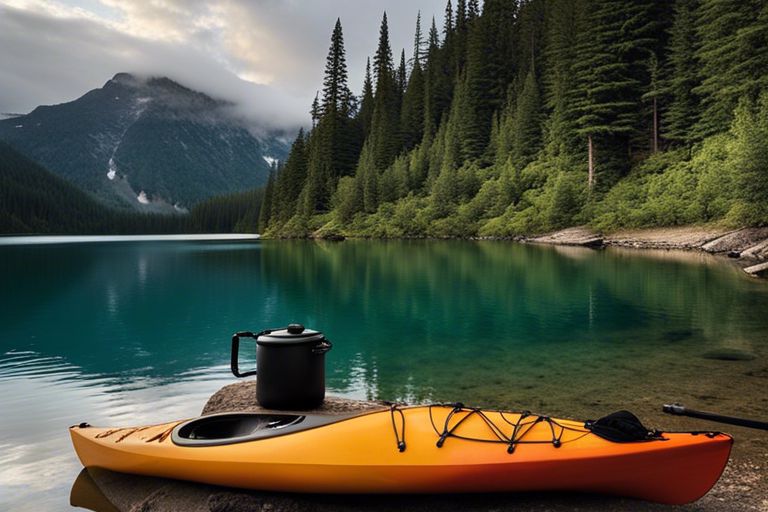With kayak camping becoming increasingly popular among outdoor enthusiasts, it’s imperative to be well-prepared for your adventure on the water. From navigating unpredictable water conditions to ensuring you have all necessary safety gear, this guide will provide you with imperative tips to make your kayak camping trip a success. Whether you are a beginner or a seasoned pro, being equipped with the right knowledge and tools is crucial for a safe and enjoyable experience in the great outdoors. Read on to discover how to plan efficiently, pack strategically, and stay safe while kayak camping.
Key Takeaways:
- Plan your route: Research the area you will be kayaking and camping in to ensure you have a detailed map and know of any potential hazards or camping regulations.
- Pack efficiently: Prioritize lightweight and compact gear to maximize space in your kayak, and pack imperatives such as food, water, shelter, and safety equipment.
- Practice paddling: Before launching on your trip, ensure you are comfortable and confident in your kayaking skills, especially if you will be navigating challenging waters.
- Choose a suitable campsite: Look for a spot that is flat, away from the water’s edge, and has access to amenities like fire pits and bathrooms, while being mindful of wildlife and vegetation.
- Be mindful of safety: Wear a life jacket at all times, stay hydrated, protect yourself from the sun, and be aware of changing weather conditions to ensure a safe and enjoyable trip.
- Leave no trace: Practice Leave No Trace principles by packing out all trash, avoiding damaging vegetation, and respecting wildlife to preserve the natural beauty of the environment.
- Enjoy the experience: Take time to appreciate the beauty of your surroundings, disconnect from technology, and make memories that will last a lifetime while kayak camping.
Planning Your Kayak Camping Trip
Selecting the Right Destination
For a successful kayak camping trip, choosing the right destination is crucial. Consider factors such as your skill level, the distance you are willing to paddle, the amenities available at the campsites, and the weather conditions during your planned trip.
What to Pack for Maximum Efficiency
For a successful kayak camping trip, packing efficiently is key. Make sure to bring crucial items such as a tent, sleeping bag, cooking supplies, food, water, navigation tools, personal gear, and safety equipment. Packing lightweight and compact items is crucial since space is limited on a kayak.
Plus, always pack extra water and snacks in case of emergencies. It’s also a good idea to pack a first aid kit and emergency supplies like a whistle and a flashlight. Don’t forget to check the weather forecast and pack appropriate clothing to stay comfortable throughout your trip.
Kayaking Skills and Safety
Essential Paddling Techniques
All successful kayak camping trips begin with mastering vital paddling techniques. Proper paddling not only helps you navigate efficiently but also ensures your safety on the water. Knowing how to execute forward strokes, backward strokes, sweeps, and braces will give you control over your kayak in various conditions. Practice these techniques in different water bodies before initiateing on your camping adventure to build confidence and skill.
Navigating Waterways and Weather Conditions
On any kayak camping trip, understanding how to navigate waterways and weather conditions is crucial for a safe and enjoyable experience. Be sure to research the water body you plan to paddle in, learn about any potential hazards or obstacles, and familiarize yourself with the local regulations. Additionally, staying informed about weather forecasts is vital. Severe weather conditions can pose serious risks to paddlers, so always check for updates before heading out. Plan your route accordingly, and be prepared to adjust your itinerary if needed based on changing weather patterns.
Setting Up Camp
Finding and Preparing a Campsite
For a successful kayak camping trip, finding and preparing a suitable campsite is crucial. Look for a flat and dry area that is at least 200 feet away from bodies of water to minimize environmental impact. Clear the site of rocks, twigs, and other debris, and consider pitching your tent on a durable surface like sand or gravel to reduce damage to vegetation.
Leave No Trace Principles
Trace principles are crucial to follow when kayak camping to ensure minimal impact on the environment. Remember to pack out all trash, including food scraps, and avoid building campfires unless in designated fire pits. Practice proper waste disposal techniques, and be mindful of noise levels to respect wildlife and fellow campers.
Another important Leave No Trace principle to abide by is to respect wildlife by observing from a distance and not approaching or feeding animals. This can prevent disruptions to natural behaviors and protect both your safety and the animals’ well-being. By following Leave No Trace principles, you are not only preserving the environment for future generations but also enhancing your overall kayak camping experience.
Sustenance and Nutrition
Meal Planning and Food Storage
For a successful kayak camping trip, it is important to plan your meals ahead of time and pack food that is lightweight, non-perishable, and easy to prepare. Consider prepping meals in advance and packing them in sealed containers to save space and prevent leaks. Opt for dehydrated or freeze-dried foods as they are lightweight and require minimal preparation. Be sure to pack enough food to sustain you throughout your trip, taking into account the extra calories you will burn while paddling and camping.
Water Treatment and Hydration Tips
Water is important for any outdoor adventure, especially when kayaking and camping. Bring along a reliable water filtration or purification system to ensure a safe supply of drinking water. Stay hydrated by regularly sipping water throughout the day, especially in hot weather. Avoid dehydration by drinking fluids before you feel thirsty, as thirst is a sign that your body is already dehydrated. Pack electrolyte tablets to replenish lost minerals during long paddling sessions.
- Stay hydrated
- Use a water filter or purifier
- Drink regularly throughout the day
- Carry electrolyte tablets
Water is crucial for your survival while kayak camping, but it can also pose risks if not properly managed. Waterborne illnesses such as giardia can ruin your trip and endanger your health. Ensure that your water filtration system is effective against common contaminants found in natural water sources. Stay vigilant about keeping your water supply clean and separate from contaminated sources. Drinking untreated water can lead to severe illnesses and ruin your entire kayak camping experience.
Troubleshooting Common Challenges
Dealing with Wildlife
Common challenges while kayak camping include encounters with wildlife. While it can be thrilling to see animals in their natural habitat, it’s important to stay cautious. To avoid conflicts, make sure to store food properly in bear-proof containers and keep a safe distance from any animal you come across. Additionally, familiarize yourself with the local wildlife and their behaviors to better handle unexpected encounters.
Managing Waste and Sanitation
Common challenges while kayak camping also involve managing waste and sanitation. It’s crucial to pack out all waste, including human waste, to minimize your impact on the environment. Always carry proper waste disposal bags and follow Leave No Trace principles to preserve the natural beauty of the places you visit. Proper sanitation practices are not only imperative for the environment but also for your health and the well-being of future campers.
Summing up
To wrap up, kayak camping can be an exciting and rewarding adventure if you follow the right tips and techniques. From proper gear selection to packing efficiently and practicing safe paddling, these guidelines will help ensure a successful trip. For more in-depth information on camping in your canoe or kayak, check out A Guide to Camping in Your Canoe or Kayak. With a little preparation and a sense of adventure, you’ll be well on your way to experiencing the great outdoors from a whole new perspective.
FAQ
Q: What is kayak camping?
A: Kayak camping, also known as paddling camping, is a form of adventure where individuals use kayaks to travel to remote camping destinations. It involves carrying all necessary gear and supplies on the kayak and setting up camp along the water’s edge.
Q: What necessary gear is needed for kayak camping?
A: Essential gear for kayak camping includes a reliable kayak, paddle, life jacket, camping tent, sleeping bag, cooking utensils, food, water, navigation tools, first aid kit, and personal items. It is important to pack light and waterproof gear for easy transport and storage.
Q: What are some tips for a successful kayak camping trip?
A: – Plan your route and check weather conditions before begining on your trip.
– Pack necessary gear and supplies in dry bags to protect them from water.
– Practice paddling and maneuvering your kayak before heading out on a long trip.
– Leave no trace by disposing of waste properly and respecting nature.
– Always wear a life jacket and follow water safety guidelines to ensure a safe trip.




